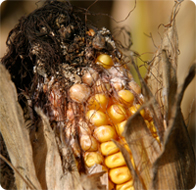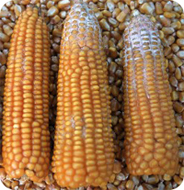
Poultry
Mycotoxins in general
Mycotoxins are highly toxic secondary metabolic products of molds on almost all agricultural commodities worldwide. They occur under natural conditions in feed as well as in food. Several studies proved that economic losses occur at all levels of food and feed production, including crop and animal production, processing and distribution. According to the FAO (Food and agriculture organization) 25% of the world's crop harvests are contaminated with mycotoxins. There are currently more than 400 mycotoxins known. There are six major classes of mycotoxins that frequently occur: aflatoxins, trichothecenes, fumonisins, zearalenone, ochratoxin and ergot alkaloids. They are formed by different kinds of fungi and each fungi species can produce more than one mycotoxin. The major classes of these mycotoxin-producing fungi are listed in the table below.Classification of mycotoxin-producing fungi
| Major classes of mycotoxin-producing fungi | Fungi species | Mycotoxins |
Aspergillus |
A. flavus A. parasiticus A. nomius A. pseudotamarii |
Aflatoxin (B1, B2, G1, G2) |
| A. ochraceus | Ochratoxin (Ochratoxin A) |
|
| A. clavatus A. terreus |
Patulin | |
| A. flavus A. versicolor |
Cyclopiazonic acid (CPA) | |
Claviceps |
C. purpurea C. fusiformis C. paspali C. africana |
Ergot alkaloids: Clavines (Argroclavine) Lysergic acids Lysergic acid amids (Ergin) Ergopeptines (Ergotamine, Ergovaline) |
Fusarium |
F. verticillioides (syn. F. moniliforme) F. proliferatum |
Fumonisin (B1, B2, B3) |
| F. graminearum F. avenaceum F. culmorum F. poae F. equiseti F. crookwellense F. acuminatum F. sambucinum F. sporotrichioides |
Type A Trichothecenes T-2 toxin, HT-2 toxin, diacetoxyscirpenol Type B Trichothecenes Nivalenol, deoxynivalenol, fusarenon-X |
|
| F. graminearum F. culmorum F. sporotrichioides |
Zearalenone | |
Penicillium |
P. verrucosum P. viridicatum |
Ochratoxin (Ochratoxin A) |
| P. citrinum P. verrucosum |
Citrinin | |
| P. roqueforti | Roquefortine PR toxin |
|
| P. cyclopium P. camemberti |
Cyclopiazonic acid (CPA) | |
| P. expansum P. claviforme P. roquefortii |
Patulin | |
| Neotyphodium (formerly Acremonium) |
N. coenophialum | Tall fescue toxins: Ergot alkaloids, lolines, peramine |
| N. lolii | Tall fescue toxins: Lolitrems, peramine, ergot alkaloid (ergovaline) |
Mycotoxins differ in their structure, which explains the great variation of symptoms (see table: "Selected mycotoxins and their basic symptoms"). The main toxic effects are carcinogenicity, genotoxicity, nephrotoxicity, hepatotoxicity, oestrogenicity, reproductive disorders, immunosuppression or dermal effects. There are several factors which influence symptoms:
- Type of mycotoxins consumed, intake level and duration of exposure
- Animal species, sex, breed, age , general health, immune status
- Farm management (hygiene, temperature, production density )
- Possible synergism between mycotoxins simultaneously present in feeds
Each plant can be affected by more than one fungus and each of them can produce more than one mycotoxin. Consequently, there is a great probability that many mycotoxins are present in one feed, thus increasing the odds of interaction between mycotoxins and the occurrence of synergistic effects, which are of great concern in livestock health and productivity. Synergistic effects can already occur at low levels when the combined effects of two mycotoxins are much greater than the individual effects of each toxin alone. In contrast additive effects that occur when the combined effects of two mycotoxins are equal to the sum of the effects of each toxin given alone.
Selected mycotoxins and their basic symptoms
| Mycotoxin | Possible effects |
| Aflatoxins | Liver diseases (hepatotoxic, hepatocarcinogenic); carcinogenic and teratogenic effects; hemorrhages (intestinal tract, kidneys); reduced growth rate; diminution of performance; immune suppression |
| Ochratoxins | Nephrotoxic; carcinogenic; mild liver damage; enteritis; teratogenic effects; poor feed conversion; reduced growth rate; immune suppression |
| Fumonisins | Pulmonary edema; equine leukoencephalomalacia; nephro- and hepatotoxic; immune suppression |
| Trichothecenes | Digestive disorders (vomiting, diarrhea, feed refusal); reduced weight gain; hemorrhages (stomach, heart, intestine, lung, bladder, kidney); edema; oral lesions; dermatitis; blood disorders; infertility; degeneration of bone marrow; slow growth; immune suppression |
| Zearalenone | Estrogenic effects; edema of vulva; prolapse of vagina; enlargement of uterus; atrophy of testicles; atrophy of ovaries; enlargement of mammary glands; infertility; abortion |
| Ergot alkaloids | Nervous or gangrenous syndromes; Digestive disorders (vomiting, diarrhea, feed refusal); reduced weight gain; convulsion; abortion |
| Fescue toxins | Effects in the immune and reproductive systems; reduced weight gain; lower feed intake; rough hair coat; high rectal temperatures; ryegrass staggers (abnormal behavior, general weakness, convulsions) |
| Cyclopiazonic acid | Necrotic effects (liver, gastrointestinal tissue, kidneys, skeletal muscles); carcinogenic; neurotoxic |
| Citrinin | Nephrotoxic; teratogenic; hepatotoxic |
| Roquefortine | Neurotoxic |
| Patulin | Mutagenic; genotoxic; neurotoxic; immune suppression |
Examples of contaminated corn
 |
 |
Mycotoxins are often invisible, tasteless, chemically stable and resistant to temperature and storage. They cannot be destroyed during the normal feed manufacturing processes.
Mycotoxin producing fungi can be divided into two groups:
Mycotoxin producing fungi can be divided into two groups:
- Field fungi (Fusarium sp.) produce mycotoxins in the field (pre-harvest)
- Storage fungi (Aspergillus and Penicillium sp.) occur after harvest (post-harvest)
However in special cases like under unusually hot or dry conditions Aspergillus and Penicillium species can also affect the grain on the field, and field fungi can continue growing and produce mycotoxins during transport and storage.






